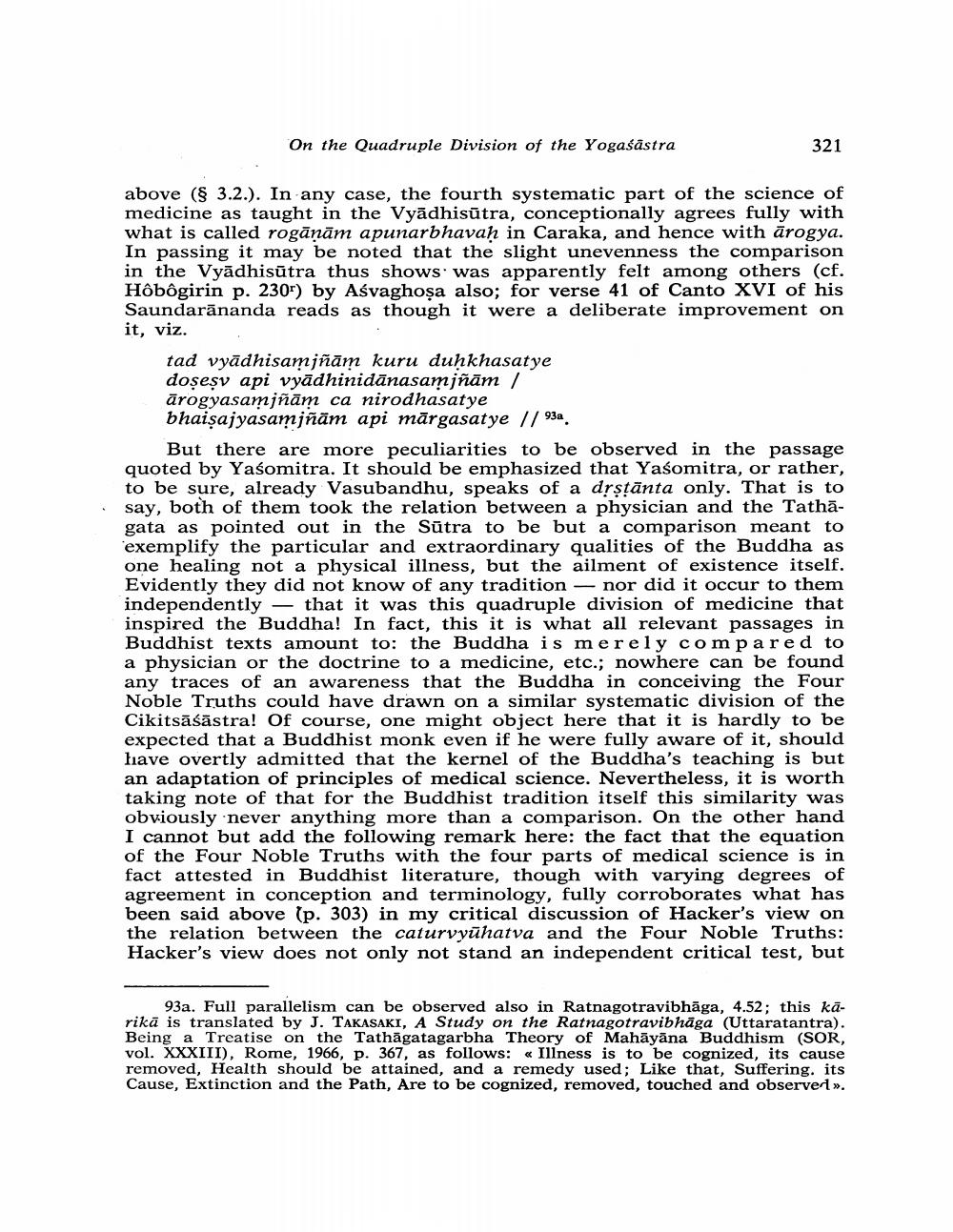________________
On the Quadruple Division of the Yogaśästra
321
above (S 3.2.). In any case, the fourth systematic part of the science of medicine as taught in the Vyādhisūtra, conceptionally agrees fully with what is called rogānām apunarbhavaḥ in Caraka, and hence with ārogya. In passing it may be noted that the slight unevenness the comparison in the Vyādhisūtra thus shows was apparently felt among others (cf. Hôbôgirin p. 230r) by Aśvaghoşa also; for verse 41 of Canto XVI of his Saundarānanda reads as though it were a deliberate improvement on it, viz.
tad vyādhisamjñām kuru duḥkhasatye doșeșv api vyādhinidānasamjñām / ārogyasamjñām ca nirodhasatye bhaişajyasamjñām api mārgasatye // 93a.
But there are more peculiarities to be observed in the passage quoted by Yaśomitra. It should be emphasized that Yasomitra, or rather, to be sure, already Vasubandhu, speaks of a drstānta only. That is to say, both of them took the relation between a physician and the Tathāgata as pointed out in the Sūtra to be but a comparison meant to exemplify the particular and extraordinary qualities of the Buddha as one healing not a physical illness, but the ailment of existence itself. Evidently they did not know of any tradition - nor did it occur to them independently — that it was this quadruple division of medicine that inspired the Buddha! In fact, this it is what all relevant passages in Buddhist texts amount to the Buddha is merely compared to a physician or the doctrine to a medicine, etc.; nowhere can be found any traces of an awareness that the Buddha in conceiving the Four Noble Truths could have drawn on a similar systematic division of the Cikitsāśāstra! Of course, one might object here that it is hardly to be expected that a Buddhist monk even if he were fully aware of it, should have overtly admitted that the kernel of the Buddha's teaching is but an adaptation of principles of medical science. Nevertheless, it is worth taking note of that for the Buddhist tradition itself this similarity was obviously never anything more than a comparison. On the other hand I cannot but add the following remark here: the fact that the equation of the Four Noble Truths with the four parts of medical science is in fact attested in Buddhist literature, though with varying degrees of agreement in conception and terminology, fully corroborates what has been said above (p. 303) in my critical discussion of Hacker's view on the relation between the caturvyūhatva and the Four Noble Truths: Hacker's view does not only not stand an independent critical test, but
93a. Full parallelism can be observed also in Ratnagotravibhāga, 4.52; this kārikā is translated by J. TAKASAKI, A Study on the Ratnagotravibhāga (Uttaratantra). Being a Treatise on the Tathāgatagarbha Theory of Mahāyāna Buddhism (SOR, vol. XXXIII), Rome, 1966, p. 367, as follows: « Illness is to be cognized, its cause removed, Health should be attained, and a remedy used; Like that, Suffering. its Cause, Extinction and the Path, Are to be cognized, removed, touched and observert».




